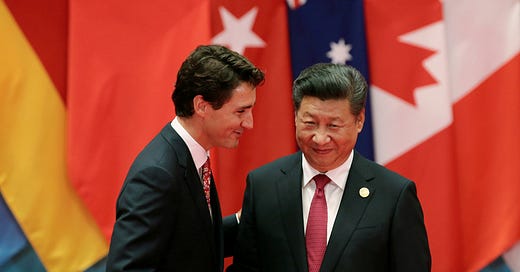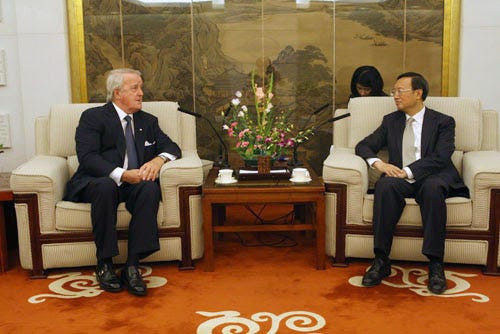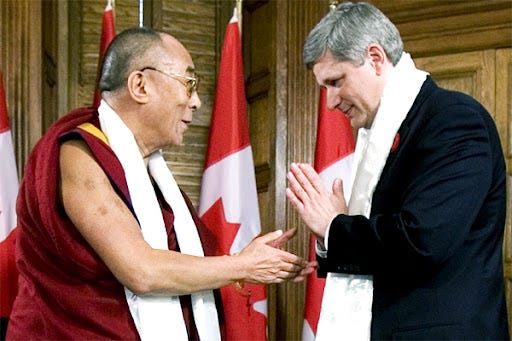Canada-China Relations: A History of Economic Ties, Tensions, and Global Influence
Voted BONUS story
This week's bonus story, chosen by my paid subscribers—thank you all for your support! I hope you enjoy this article. There's so much depth to explore in Canada-China relations, but I’ve done my best to summarize the key points for you. Enjoy the read!
The Broader Picture: Why China is Considered a Threat to Democracy
Before diving into Canada’s relationship with China, it’s important to clarify that this discussion is not an attack on Chinese people or culture. Instead, it is an examination of how the Chinese Communist Party (CCP) exerts economic and political influence worldwide.
China is a one-party authoritarian state, ruled by the CCP since 1949. Traditionally, leaders have served two five-year terms, but Xi Jinping has dismantled these limits, effectively making himself president for life. By hand-picking party officials and consolidating power, he ensures that internal challenges to his rule are nearly impossible.
In China, economic success comes with an unwritten rule: loyalty to the CCP is paramount. Those who step out of line—no matter how powerful—risk losing everything. Jack Ma, the billionaire founder of Alibaba, disappeared for three months after criticizing China’s financial regulators. Real estate tycoon Ren Zhiqiang was jailed after publicly mocking Xi Jinping. These cases serve as stark reminders that wealth and status in China exist only at the pleasure of the state.
Beyond its borders, China is just as aggressive in maintaining control. Within the country, dissent is met with swift and brutal force. In 1989, millions of Chinese citizens took to the streets in the Tiananmen Square protests, demanding democracy and freedom. The CCP responded with overwhelming military force, sending in tanks and armed troops to massacre thousands of peaceful protesters. Any mention of the event today is strictly forbidden, and journalists who attempt to report on it face imprisonment.
The suppression of dissent extends to China’s ethnic minorities. Re-education camps operate in regions like Tibet and Xinjiang, where millions of Uyghurs and Tibetans are subjected to forced labor, indoctrination, and sterilization. For years, the Chinese government denied these camps even existed, until satellite images and survivor testimonies made their presence undeniable. Tibet, in particular, has become one of the most heavily monitored places on Earth, with facial recognition, AI surveillance, and police checkpoints controlling every aspect of daily life. Foreign journalists and human rights organizations are banned from entering, ensuring that the CCP alone controls the narrative.
China’s authoritarian grip extends beyond its borders. In 2022, it was revealed that the CCP had set up at least 110 secret police stations in foreign countries, targeting Chinese dissidents abroad. These stations, discovered in Canada, the U.S., the UK, and Spain, were reportedly used to harass, intimidate, and in some cases, kidnap individuals who had fled China.
Another key element of China’s influence strategy is what’s known as "debt-trap diplomacy." The CCP funds major infrastructure projects in developing nations, often under terms that lead to financial dependence. When these countries struggle to repay their debts, China seizes control of key assets, using them as leverage to gain political and military footholds. Nations like Zambia, Venezuela, the Solomon Islands, Djibouti, Laos, Cambodia, Sri Lanka, and Pakistan have all found themselves caught in this web of economic manipulation.
China has also leveraged its dominance in global manufacturing, flooding international markets with cheap goods. This economic supremacy is largely built on the backs of forced labor, both within its borders and in debt-ridden countries where China has established factories. Uyghur forced labor in Xinjiang, for example, is believed to be deeply embedded in supply chains for various industries, including electric vehicle (EV) production. By artificially lowering costs, China outcompetes Western manufacturers, tightening its economic stranglehold on global markets.
Canada-China Relations: From Trade Partners to Diplomatic Crisis
Canada was one of the first Western nations to formally recognize the People’s Republic of China in 1970, under the leadership of Prime Minister Pierre Trudeau. By the 1980s and 1990s, economic ties were flourishing, with Prime Minister Brian Mulroney visiting China in 1984 to strengthen relations. By 2000, China had become Canada’s second-largest trading partner
However, tensions were never far from the surface. The 1989 Tiananmen Square massacre marked the first major strain in relations, as Canada condemned China’s human rights abuses. Despite this, trade continued to grow, leading to what many considered a pragmatic, if uneasy, partnership.
Human rights concerns became impossible to ignore in the 2000s. In 2008, Prime Minister Stephen Harper met with the Dalai Lama, drawing China’s ire. The Dalai Lama, who had been Tibet’s spiritual and political leader before fleeing to India in 1959, advocated for Tibetan autonomy and human rights—something the CCP considered a direct threat. In response, China ramped up its efforts to assimilate Tibetans, demolishing Buddhist academies and separating Tibetan children from their families to be raised in state-controlled schools.
During this period, China also showed its willingness to retaliate against Canadian citizens. In 2006, Chinese authorities arrested Huseyin Celil, a Uyghur-Canadian activist, while he was visiting Uzbekistan. He was extradited to China, convicted in a secret trial with no legal representation, and sentenced to life in prison, later reduced to 20 years. To this day, Canadian officials and his family have been denied access to him.
From 2006 to 2010, Harper publicly criticized China’s human rights abuses, leading to strained relations. However, economic concerns led to a shift in policy. In 2012, Harper signed a controversial free trade deal with China, seen by many as a concession. That same year, China’s state-owned CNOOC acquired Canadian oil company Nexen for $15 billion, raising alarm over foreign control of Canadian resources.
Under Prime Minister Justin Trudeau, relations remained complicated. Trudeau criticized China’s human rights record but was bound by Harper’s 31-year trade agreement, which had no exit clause. Tensions escalated in 2018 when Canada arrested Huawei CFO Meng Wanzhou at the request of the United States. The U.S. accused Meng of fraud, claiming that Huawei had secretly conducted business in Iran through a front company, violating American sanctions. In response, China arrested two Canadians—Michael Kovrig and Michael Spavor—on espionage charges, a move widely seen as "hostage diplomacy." China also retaliated economically, banning Canadian canola imports.
After nearly three years, a deal was struck. In 2021, Meng was released after reaching an agreement with U.S. prosecutors, and within hours, China freed the two Canadians—confirming that their arrests had been politically motivated.
Where We Are Today: A Trade & Security Showdown
Canada’s stance on China has hardened in recent years. In 2021, it joined allies in officially recognizing China’s treatment of Uyghurs as genocide. The following year, investigations uncovered China’s secret police stations within Canada, leading to further diplomatic fallout. In 2023, Canada banned Huawei from its 5G networks, citing national security risks.
Now, a new trade war is unfolding. In 2024, Canada imposed 100% tariffs on Chinese EVs, fearing that they were heavily subsidized by the CCP and linked to forced labor. China responded by slapping 100% tariffs on Canadian canola and additional duties on pork and seafood. This tit-for-tat escalation signals that Canada-China relations are at their lowest point in decades.
The Big Picture: Can Canada Break Free from China’s Influence?
For decades, China has used economic leverage, espionage, and coercion to expand its influence. Now, Canada faces a critical decision: should it attempt to mend relations for the sake of economic stability, or move toward full decoupling? The next few years will determine whether Canada can forge a new path, independent of Beijing’s grip, or whether economic realities will force continued engagement with a regime that has repeatedly shown its willingness to use force, intimidation, and economic blackmail to achieve its goals.






Great information, thanks very much!
Thank you for this breakdown.